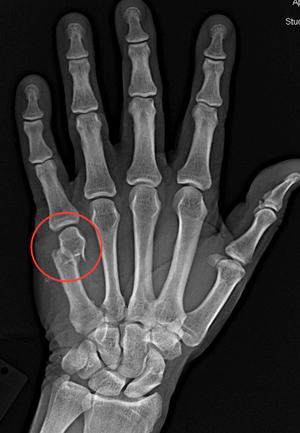As the name suggests, a Boxers fracture typically occurs when an individual strikes an object with a closed fist as seen in professional boxing. A boxers fracture specifically involves the fracture of the 5th metacarpal bone (little finger) and is also referred to as a ‘bar room fracture’ or ‘scrappers fracture.’
Signs You Have Suffered A Boxers Fracture
If following a punch or strike of an object you experience pain and localized tenderness of the little finger than it is highly likely that you have suffered a boxers fracture. Accompanying pain and tenderness you may also physical hear an audible ‘clicking’ or ‘popping’ sound during the injury or notice swelling or bruising around the finger and knuckle. As is common with fractures or skeletal injuries, movement restriction will be evident.
Mechanism Of Injury
Metacarpal fractures are usually the result of impact injuries such as a clenched fist with a hard, immovable object, such as a skull or a wall. Improper technique or shear force are the typical mechanism of injury.
Assessment & Diagnosis
While Chiropractors are musculoskeletal experts of both the spine and peripheral extremities, a boxers fracture is out of our treatment domain. It is important to have your injury assessed by x-ray or CT imaging to ascertain the extent of the sustained injured. This will dictate the appropriate treatment. Conservative management typically involves application of a splint to immobilize the fingers and hand. If the fractured site is displaced then surgical intervention may be recommended.
Prognosis
A Boxers fracture doesn’t usually pose any great risk for recovery or future disability. Total healing time is approximately 3 months, however complete bone remodeling takes place over 12 months. Initially it is important to reduce swelling and pain free movement of the fingers. When flexibility of the wrist, hand and fingers has returned to pre-injury levels, rehabilitation of the hand muscles is important. For specific exercise advice, please consult with an appropriately trained exercise professional or your specialist. Is there another hand fracture more common than a Boxer’s fracture? Find out here.


Recent Comments